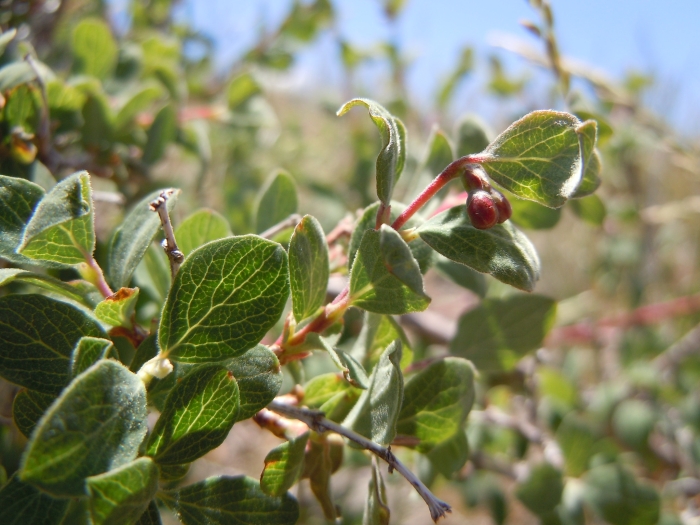Mountain Snowberry
(Symphoricarpos oreophilus)
Mountain Snowberry (Symphoricarpos oreophilus)
/
/

Matt Lavin
CC BY-SA 2.0
Image By:
Matt Lavin
Recorded By:
Copyright:
CC BY-SA 2.0
Copyright Notice:
Photo by: Matt Lavin | License Type: CC BY-SA 2.0 | License URL: https://creativecommons.org/licenses/by/2.0/ | Uploader: Matt Lavin | Publisher: Flickr |


























Estimated Native Range
Summary
Symphoricarpos oreophilus, commonly known as Mountain Snowberry, is a deciduous shrub native to a variety of habitats including open woodlands, forest edges, and the understory of coniferous forests across the Western USA, British Columbia, and Mexico. It exhibits a variable growth habit, typically reaching 30 centimeters (12 inches) to 1.5 meters (4.9 feet) in height, with a similar spread. The plant is characterized by its slender branches and oval, bluish-green leaves. During spring, it produces small, bell-shaped, white flowers that are modest in appearance. By late summer, it bears distinctive white drupes, each containing two nutlets with seeds, which persist into winter and provide food for wildlife.
Mountain Snowberry is valued for its wildlife-friendly attributes and its ability to stabilize soil with its rhizomatous root system, making it suitable for restoration projects and naturalized plantings. It is also used as an ornamental in shaded garden areas, where its low water requirements and tolerance of medium to slow-draining soils make it a low-maintenance choice. While it thrives in part shade, it can also adapt to full sun in cooler climates. Gardeners should note that while generally disease-resistant, it can be susceptible to leaf spots and powdery mildew in humid conditions. Additionally, its spreading nature may require management in smaller garden settings to prevent unwanted naturalization.CC BY-SA 4.0
Mountain Snowberry is valued for its wildlife-friendly attributes and its ability to stabilize soil with its rhizomatous root system, making it suitable for restoration projects and naturalized plantings. It is also used as an ornamental in shaded garden areas, where its low water requirements and tolerance of medium to slow-draining soils make it a low-maintenance choice. While it thrives in part shade, it can also adapt to full sun in cooler climates. Gardeners should note that while generally disease-resistant, it can be susceptible to leaf spots and powdery mildew in humid conditions. Additionally, its spreading nature may require management in smaller garden settings to prevent unwanted naturalization.CC BY-SA 4.0
Plant Description
- Plant Type: Shrub
- Height: 3-5 feet
- Width: 3-5 feet
- Growth Rate: Moderate
- Flower Color: White, Pink
- Flowering Season: Spring
- Leaf Retention: Deciduous
Growth Requirements
- Sun: Part Shade
- Water: Medium, High
- Drainage: Medium
Common Uses
Bee Garden, Bird Garden, Butterfly Garden, Deer Resistant, Drought Tolerant, Erosion Control, Fire Resistant, Groundcover, Hummingbird Garden, Low Maintenance, Street Planting
Natural Habitat
Open woodlands, forest edges, and the understory of coniferous forests
Other Names
Common Names: Whortleleaf Snowberry
Scientific Names: , Symphoricarpos oreophilus, Symphoricarpos oreophilus var. oreophilus, Symphoricarpos rotundifolius var. oreophilus, Symphoricarpos montanus,
GBIF Accepted Name: Symphoricarpos oreophilus A.Gray